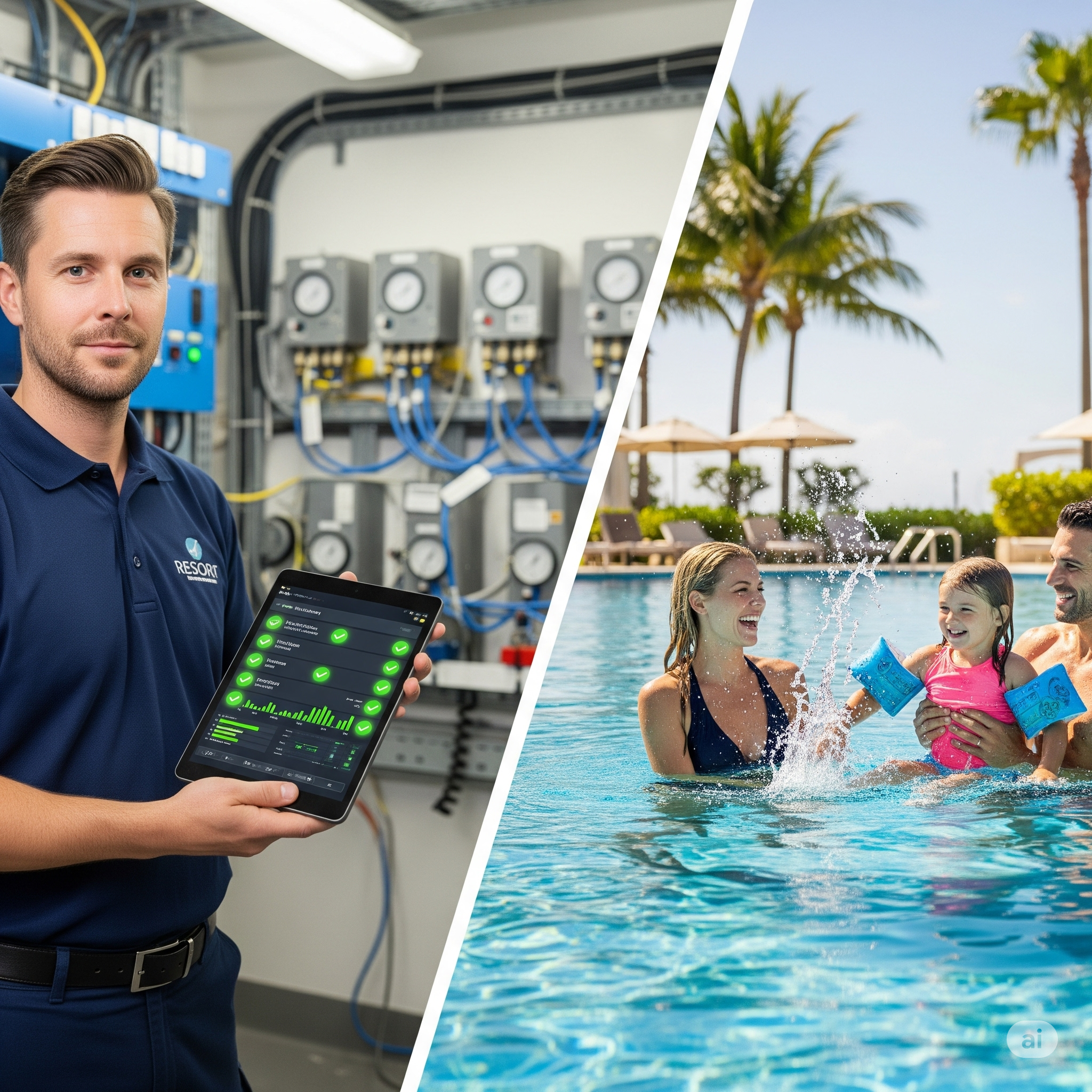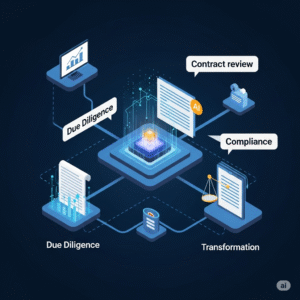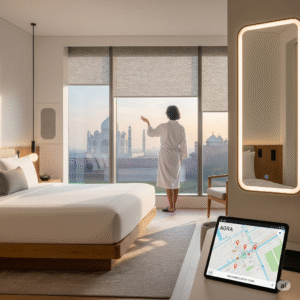Picture this: you’ve finally arrived at the beautiful resort you’ve been dreaming of for months. You check into your room, ready to unwind, only to find the air conditioning is blowing hot air. Or worse, you head to the stunning infinity pool, only to be met with a “Closed for Unforeseen Maintenance” sign. These frustrating moments are the kryptonite of a perfect vacation, turning relaxation into a series of complaint calls. For decades, this reactive “fix-it-when-it-breaks” model was the norm. But what if a resort could know its AC unit was going to fail next week and fix it while you were out on a tour? This is the power of predictive maintenance, and it’s being supercharged by AI resort maintenance.
This technological revolution is quietly working behind the scenes to ensure your stay is flawless. It’s about shifting from a reactive stance to a proactive, predictive one. By leveraging the power of artificial intelligence, resorts can monitor the health of their entire infrastructure in real-time, preventing disruptions before they ever impact a guest. This leap forward is not just about fixing things; it’s about optimizing AI hospitality efficiency, saving costs, and, most importantly, protecting the sanctity of the guest experience from start to finish.
What is AI Resort Maintenance? Beyond the Toolbox
At its core, AI resort maintenance is the use of artificial intelligence to analyze data from a resort’s equipment and predict when a part is likely to fail. It marks a significant evolution from traditional maintenance strategies. Let’s break down the difference:
- Reactive Maintenance: The classic model. Something breaks, a guest complains, and a team scrambles to fix it. This is disruptive, expensive, and terrible for guest satisfaction.
- Preventative Maintenance: A step up. Maintenance is performed on a fixed schedule (e.g., servicing every AC unit every six months), regardless of its actual condition. This is better but can lead to unnecessary work and still misses unexpected failures.
- Predictive (AI) Maintenance: The gold standard. IoT (Internet of Things) sensors are placed on critical equipment like HVAC systems, water heaters, elevators, and pool pumps. These sensors constantly stream data—like temperature, vibration, and energy consumption—to an AI platform. The AI analyzes this data, learns the normal operating patterns, and identifies tiny anomalies that signal a future failure. It can then automatically create a work order for the maintenance team to fix the issue during a slow period, long before it becomes a guest-facing problem.
This data-driven approach is the cornerstone of modern AI resort maintenance, transforming the facilities department from a cost center into a strategic asset for guaranteeing guest satisfaction.
The Tangible Benefits of AI Resort Maintenance for Guests
While the technology operates behind the scenes, its impact on the guest experience is front and center. Travelers may not know why their stay was so smooth, but they will certainly feel the results of a well-oiled operation.
Ensuring Uninterrupted Comfort and Luxury
The ultimate luxury is a seamless experience where everything simply works. A robust AI resort maintenance program is the invisible thread that makes this happen. It means the water pressure in the shower is always perfect because the AI detected a slight pressure drop in the pump and scheduled a check-up. It means the room is always at the perfect temperature because the AI identified a filter that needed cleaning before it could impact performance. For guests at a premium resort, whether in a global hub or a serene location like Rishikesh, this reliability is not a bonus; it’s the expected standard.
This proactive approach ensures that the amenities a guest booked are always available and functioning perfectly, from the gym equipment to the spa’s sauna. It eliminates the negative experiences that lead to bad reviews and ensures the resort’s physical environment consistently lives up to its brand promise.
Driving AI Hospitality Efficiency Behind the Scenes
The benefits for the resort’s operational health are just as profound. By optimizing maintenance, a resort can significantly improve its bottom line and streamline its workforce, a core goal of enhancing AI hospitality efficiency.
Reducing Costs and Minimizing Downtime with AI Resort Maintenance
Emergency repairs are costly. They often involve expensive rush-order parts, overtime pay for staff, and potential revenue loss from an out-of-service room or amenity. AI resort maintenance drastically reduces these instances. By scheduling repairs proactively, the resort can order parts at standard prices and perform the work during regular hours. Furthermore, a well-maintained piece of equipment runs more efficiently, consuming less energy and extending its own lifespan, leading to significant long-term savings. This strategic asset management is a key advantage of adopting an AI resort maintenance system.
This approach also minimizes costly downtime. Instead of closing the entire pool for a day to fix a broken pump, the maintenance team can perform a 30-minute part replacement during the early morning hours when no one is swimming, all because the AI gave them a two-week heads-up.
Case Studies: Resorts Leading the Way in Smart Maintenance
The adoption of predictive maintenance is a key differentiator for leading hospitality brands that prioritize operational excellence.
Case Study 1: Siemens and Hilton’s Smart Building Partnership
Global technology powerhouse Siemens has partnered with major hotel chains like Hilton to implement smart building technology. Using Siemens’ IoT platforms, Hilton properties can monitor energy consumption and equipment performance across their entire portfolio. The AI-driven system analyzes data from thousands of sensors to identify inefficiencies and predict maintenance needs for critical systems like chillers and boilers. According to a McKinsey report on digital transformation, this data-centric approach not only reduces energy costs by double-digit percentages but also allows for proactive maintenance, ensuring guest comfort is never compromised and boosting overall AI hospitality efficiency.
Case Study 2: C3 AI at a Major Las Vegas Resort
A large, integrated resort in Las Vegas, with thousands of rooms and complex facilities, utilizes the C3 AI platform for predictive maintenance. The resort’s infrastructure includes miles of HVAC systems, hundreds of elevators, and intricate water features. The AI platform ingests data from building management systems and thousands of IoT sensors. It uses machine learning models to predict system failures with a high degree of accuracy. This has allowed the resort to decrease equipment downtime significantly, reduce maintenance costs, and ensure that failures in one part of the massive complex do not cascade into guest-facing problems, a testament to the power of scalable AI resort maintenance.
The AI Toolkit for Proactive Resort Management
Bringing AI into your maintenance operations is more accessible than ever, with tools designed for various levels of technical expertise.
- Power BI: A powerful data visualization tool from Microsoft. A resort manager can connect it to their maintenance logs to create dashboards that show which assets require the most frequent attention, the average time to repair, and maintenance costs over time, helping to spot trends manually.
- ChatGPT: This versatile AI can be an invaluable support tool. Use it to generate standardized safety protocols for maintenance procedures, create clear and concise training manuals for new equipment, or even draft internal communications about the rollout of a new AI resort maintenance initiative.
- AI-Powered CMMS Platforms: Modern Computerized Maintenance Management Systems (CMMS) like UpKeep and MaintainX are now integrating AI. They use data to automatically schedule work orders, manage spare parts inventory, and provide analytics on asset performance.
A Beginner’s Workflow for Implementing AI-Powered Maintenance
For a boutique resort or smaller property, diving headfirst into a full-scale AI deployment might be daunting. Here’s a practical, step-by-step approach:
- Digitize Your Logs: First, move away from paper. Start tracking all maintenance requests and completed work in a simple digital format like Google Sheets or a basic CMMS. This creates the foundational data you need.
- Identify Your MVAs (Most Valuable Assets): You don’t need to monitor everything. Identify the 5-10 pieces of equipment whose failure would cause the most guest disruption and financial loss (e.g., the main water heater, the primary pool pump, the elevator).
- Analyze Your Historical Data: After a few months, look at your digital logs. Are there patterns? Does the AC in a specific wing always seem to have issues in May, just before the Rishikesh peak season? Use these simple, human-driven insights to schedule preventative work.
- Pilot a Small IoT Project: Invest in a few inexpensive IoT sensors (for things like vibration or temperature) and place them on one of your MVAs. Connect them to a simple dashboard to see the type of real-time data you can collect. This small-scale test can build the case for a wider investment and is a great first step in AI resort maintenance. For more ideas, check out this HubSpot guide on business experimentation.
The Future of AI Resort Maintenance and Guest Experiences
The journey of AI resort maintenance is just getting started. The future promises even deeper integration and intelligence.
The Fully Integrated Smart Resort
Looking ahead, AI resort maintenance systems will be fully integrated with a resort’s Property Management System (PMS). The AI will know which rooms are unoccupied and for how long. It can then schedule non-urgent repairs, like replacing a worn-out part in the minibar fridge, to coincide perfectly with a room’s vacant period. This ensures zero impact on guest experience and maximum operational efficiency.
Sustainability and Green Hospitality
Efficiency and sustainability go hand in hand. A well-maintained HVAC system consumes less electricity. A water pump running at peak performance uses less energy and wastes less water. By ensuring every piece of equipment is operating at its optimal level, AI resort maintenance will play a crucial role in helping resorts reduce their carbon footprint, conserve resources, and operate as responsible stewards of their environment. This is a critical component of modern AI hospitality efficiency.
Ultimately, the goal of a great resort is to create an environment where guests can escape and relax without a single worry. AI resort maintenance is the silent guardian that makes this possible, ensuring the physical world of the resort is as flawless as the memories its guests came to create.
Hotel Prices Just Changed Again! The AI Behind Travel Costs.



